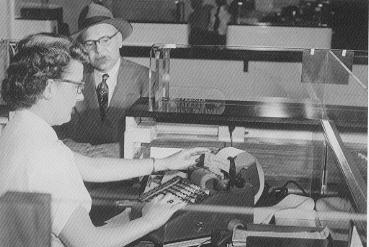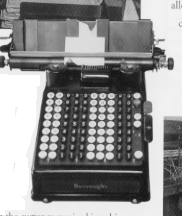Teller
Machines – The Early Days.
Submitted by Don Hooper
The type of teller machine
that was used when I started working with them in 1957 was very much like an
adding machine.
There was a numbered keyboard
with ten rows by seven rows of keys allowing for accepting of deposits up to
$99,999.99 partially illustrated as follows:
9 9 9 9 9 9 9
8 8 8 8 8 8 8
7 7 7 7 7 7 7
6 6 6 6 6 6 6
5 5 5 5 5 5 5
4 4 4 4 4 4 4
3 3 3 3 3 3 3
2 2 2 2 2 2 2
1 1 1 1 1 1 1
0 0 0 0 0 0 0
A large key on the right
hand side of the machine, when pressed, activated the machine and printed
the receipt, or printed the Cash In or Cash Out Ticket. By depressing the keys in each row as needed
allowed for infinite variations of transaction amounts. Early machines had a hand crank, but then
electric machines were purchased and placed in our branch offices. There was a very small lever above the keyboard
which allowed you to print more than one receipt….each time you moved
it forward, the machine would recycle and reprint the same transaction
number and dollar amount represented by the depressed keys.

The machine utilized a large
spool of carbonized paper. The paper was
in two parts, the top paper was blank, and on its back was carbon ink. The second part was the tape on which each
transaction was printed, and became a permanent record, which was retained in
the teller envelope at the end of the day.
These spools had to be changed periodically as they were used up. At the end of the roll a “red” banding began
to appear to warn the teller of the need to replace the tape. This usually took about a minute to pull the
old tape and replace it with a fresh tape.
It always seemed to occur on the busiest Friday’s at the worst possible
time.
Checks were cashed, stamped
with the teller’s initial stamp, and placed in small container for pickup by
the proof operator periodically during the business day. Deposits to MNB Accounts were placed in one
of the compartments, and deposits to other banks in another compartment. Cash In and Cash Out tickets representing
cash received / paid out over the counter were printed using the teller machine
and placed with the deposit if cash was part of the transaction. Cash In tickets were usually white and Cash Out Tickets were usually blue. Savings deposits and Savings withdrawals
were placed in the other compartments of the container.
The blank customer receipt, and the deposit ticket were placed in the upper
portion of the teller machine so that the print heads would print a receipt and
the same transaction information was printed on the deposit ticket. This consisted of the date, transaction
number (which changed with each deposit), the amount of the deposit, and the
teller machine number. The teller tape
reflected this information for each transaction. The date had to be changed each day of each
machine. This was done by the teller.
When the proof operator
picked up the teller transactions they were microfilmed first, then processed through the proof operation. This consisted of a twenty pocket proof
machine located in the back of the branch, or in the basement if the branch had
a basement. The noise of the machine was
pretty significant.
Tellers also accepted
utility bills, telephone, gas, water, electricity, and the customer received
one/half the bill stamped and the teller kept the other half or stub. At the end of the day these were separated
and an adding machine tape was run to determine the total for each class of
bill payment. We deducted from each
utility bill the bank’s fee of $.05 or $.10 per bill accepted.
All transactions, which
required a calculation, i.e., check to be cashed, less savings deposit and
payment of two utility bills, was done on a scratch
pad in pencil.
243.25
-50
-11.25
-15.75
166.25 paid to customer.
Branches might have had
one adding machine for the entire teller staff.
All scratch paper, adding machine tapes, teller machine tapes,
were placed in the teller’s daily envelope.
This envelope was completed each day for each teller, and reflected
the beginning cash on hand, the total of Cash In and Cash Out tickets,
and the ending cash on hand balance. Periodic
surprise audits….cash counts…were conducted to insure that all the cash
reflected on the envelope was in the teller’s cash box.
Overages and shortages had to be notated and entries processed
each day to insure that tellers were always in balance.
If discrepancy was found in a cash count audit, it could lead to
dismissal.
 An Adding Machine from the "early days."
An Adding Machine from the "early days."
Personal Money Orders and
Cashier Checks were issued, and an embosser was used to impress the amount of
the check on its face. The payee, on
Cashier Checks, was hand typed. There
was only one embosser for this purpose in the entire branch office. Everybody had to leave the teller cage and
walk (or run!) to the embosser every time a customer purchased a money order or
cashier check.
Savings Bonds were issued in
the same manner. The owner and
beneficiary were typed on the face of the bond.
Savings bonds were kept in a common box at the back of the teller line
for everyone’s availability. A log book
was maintained to insure that all bonds were accounted for. Traveler Checks were handled in a similar
manner.
When a savings customer
wished to make a withdrawal, the teller would have to leave the teller cage, go
to the area of the branch where the savings ledger cards were kept. These accounts were in numerical order, i.e.
23-2005 (representing branch 23, account 2005), and the corresponding ledger
card was pulled from its place in the drawer, the signature verified either
with the one on the card, or from the signature card filed in the savings signature
card file. Once the balance was verified
to determine that the savings account had more than the amount to be withdrawn,
the ledger card was placed in the front of the ledger. This allowed the savings bookkeeper to pull
all withdrawals easily. Savings deposits
had to be pulled once all the savings deposit tickets had been sorted into
number order. The bookkeeper would then
post the deposits and withdrawals to the cards using the Sensimatic
posting machine. These were posted by
ledger, and balanced each day. Some
branches, particularly the oldest offices, had thousands of savings accounts,
and a wide variety of numbering schemes.
The savings accounts were generally separated into what was called
ledgers. About 500 savings accounts
would constitute a ledger. The total of
each of these groups of ledgers…there could be 40 or 50 ledgers….represented
the total savings account balances for that particular office. These ledgers had to be balanced on a monthly
basis, by using an adding machine to run the individual balance on each
card. When totaled, this had to agree
with that ledgers balance card.
Interest was hand calculated
each quarter, penciled on the card, and then posted to the card by machine or
by hand printing and adding the amount of interest to the account balance. Interest calculation was an ongoing and
continuous process throughout the year.
The entire collection of
savings ledger cards was called the savings tub. The container in which they were stored had a
locked, sliding top. When the top was
opened and pushed to the back, the drawers containing the ledger cards were
automatically raised to a higher level for easy access. When the tub was locked at night, the top was
pulled forward and the ledger cards then dropped to a lower level. These tubs were supposed to be fire
resistant, but thankfully not many were ever tested in a real fire.